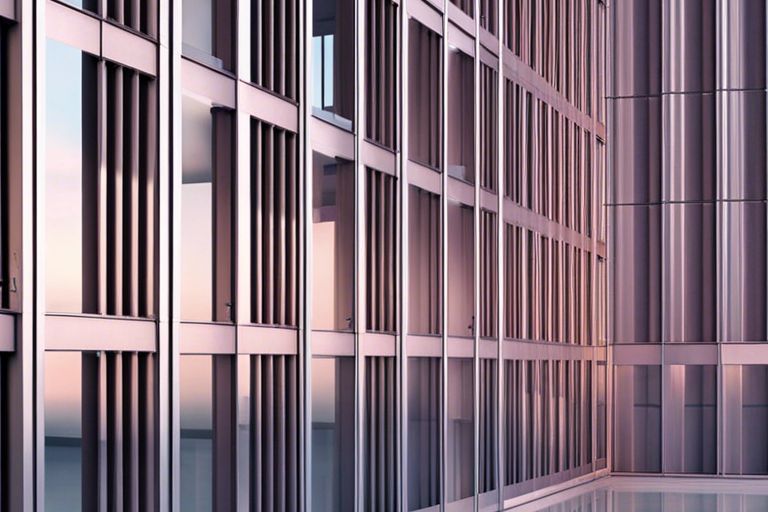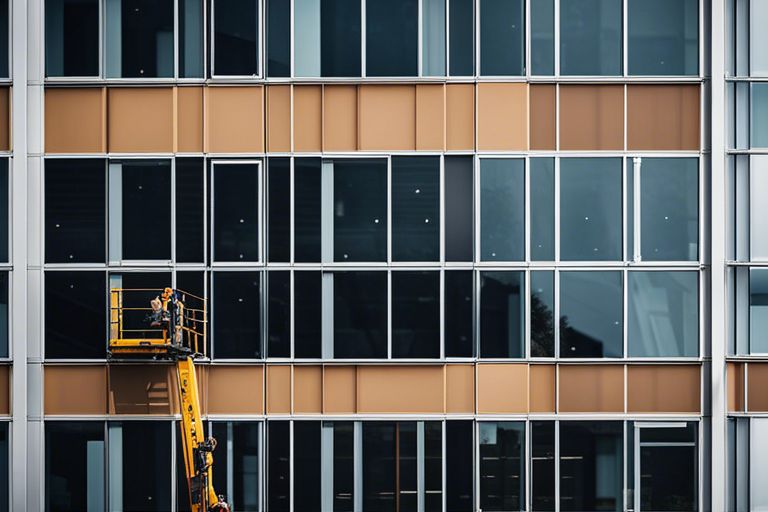Curatin Walling is a crucial element in modern architectural design, providing both functional and aesthetic benefits to buildings. In this comprehensive guide, we probe into the intricacies of curtain walling, uncovering its importance, components, and installation process. Understanding the significance of curtain walling is vital in enhancing a building’s energy efficiency and natural light intake, but improper installation can lead to structural issues and water leakage. Let’s navigate through the complexities of curtain walling to gain a thorough knowledge of this architectural feature.
Key Takeaways:
- Curtain walling is a non-structural system that separates the interior and exterior of a building, providing protection from the elements while allowing natural light to enter.
- Types of curtain walling systems include stick systems, unitised systems, and structural glazing systems, each offering unique benefits and design possibilities.
- Key components of curtain walling include mullions, transoms, infill panels, gaskets, and sealants, which work together to create a functional and aesthetically pleasing facade.

Historical Overview of Curtain Wall Systems
Curtain walling has a rich history dating back to ancient civilisations such as the Romans and Egyptians, who utilised rudimentary forms of non-structural cladding to protect their buildings from the elements. However, the modern concept of curtain wall systems began to emerge in the early 19th century as advancements in materials and construction techniques allowed for the development of more innovative designs.
Evolution from Past to Present
The evolution of curtain wall systems from the past to the present day is a testament to human ingenuity and technological progress. From early iterations made of steel and glass in the early 20th century to the sleek and energy-efficient designs of today, architects and engineers have continually pushed the boundaries of what is possible with curtain walling.
With each passing decade, we have seen increased emphasis on sustainability, safety, and aesthetics in curtain wall design. This evolution has been driven by a combination of factors, including advancements in materials, construction techniques, and environmental awareness. As a result, contemporary curtain wall systems not only enhance the visual appeal of buildings but also contribute to their overall performance and efficiency.
Technological Advances in Curtain Wall Design
Technological advances in curtain wall design have revolutionised the way we approach building facades. The use of computer-aided design (CAD) software has allowed architects to create intricate and complex curtain wall systems with pinpoint accuracy, while 3D printing technology has enabled the production of customised components at a faster pace.
Moreover, innovations in materials such as high-performance glass, aluminium, and composite panels have significantly enhanced the durability and thermal efficiency of curtain wall systems. These advancements have not only improved the aesthetics of buildings but also boosted their energy efficiency and overall sustainability.

Types of Curtain Walling
Curtain walling comes in various types, each with its own set of characteristics and unique features. Understanding the different types of curtain walling systems is crucial in selecting the most suitable option for a particular project.
- Stick Systems
- Unitized Systems
- Structural Glazing
| Stick Systems | Unitized Systems |
| Cost-effective | Factory-assembled |
| Versatile | Quick installation |
| Customizable | Highly efficient |
| Labour-intensive | Excellent for high-rise buildings |
| Time-consuming installation | Seamless appearance |
Stick Systems
Stick systems are the traditional method of curtain walling installation, where components are assembled on-site piece by piece. This system offers versatility in design and is cost-effective compared to other methods. However, the installation process can be labour-intensive and time-consuming.
Unitized Systems
Unitized systems are factory-assembled curtain walling units that are transported to the site for quick installation. These systems are highly efficient and are known for their quick installation process. They are ideal for high-rise buildings and provide a seamless appearance. The customizable nature of unitized systems allows for various design options to be implemented with ease.
Unitized systems offer a modern approach to curtain walling, providing efficiency and quality in construction projects. They are designed for speed and precision, reducing the overall assembly time and ensuring a consistent quality across all units.
Structural Glazing
Structural glazing is a form of curtain walling that utilises glass units bonded to the structure without the use of visible frames. This system provides a sleek and modern look to buildings while offering maximum transparency and natural light penetration. Structural glazing is popular in contemporary architecture for its aesthetic appeal and design flexibility.
Structural glazing is suitable for projects where a seamless, all-glass appearance is desired. It offers architectural freedom in design while providing structural integrity and weather performance. This system is complex to install and requires specialised expertise but delivers impressive results in terms of aesthetics and performance.
Design Considerations and Performance
When it comes to curtain walling design, there are several key considerations that must be taken into account to ensure optimal performance. These include the aesthetic aspects, energy efficiency, sustainability, safety, and compliance with building codes. Each of these factors plays a critical role in determining the overall success of a curtain wall system.
Aesthetic Aspects
One of the primary considerations when designing curtain walling is the aesthetic appeal of the system. The design must complement the overall architecture of the building while also meeting the client’s vision. Factors such as material choice, colour, profile, and transparency levels all contribute to the aesthetic impact of the curtain wall. Attention to detail is crucial in creating a visually stunning facade that enhances the building’s overall appearance.
Energy Efficiency and Sustainability
Another critical aspect of curtain walling design is energy efficiency and sustainability. Incorporating features such as thermal breaks, energy-efficient glazing, and smart shading systems can significantly reduce a building’s energy consumption. By improving insulation and maximising natural light, a well-designed curtain wall system can enhance both energy efficiency and occupant comfort.
In addition to energy efficiency, sustainability is becoming increasingly important in modern building design. The use of recycled materials and consideration for the environmental impact of the manufacturing process are key factors to be taken into account when designing curtain walling systems.
Safety and Building Codes Compliance
Ensuring safety and compliance with building codes is non-negotiable when it comes to curtain walling design. The system must be able to withstand various loads, such as wind, snow, and seismic forces, to guarantee the safety of building occupants. Fire safety considerations are also crucial, with fire-rated materials and designs often required to meet building regulations.
Regular testing and certification are essential to verify the structural integrity and safety of curtain wall systems. Compliance with building codes and standards not only ensures the safety of the building but also provides peace of mind for designers, architects, and building owners.

Installation and Maintenance
When it comes to curtain walling installation and maintenance, following best practices is crucial to ensure the longevity and performance of the system. Proper installation is essential for the structural integrity and weatherproofing of the building envelope. Regular maintenance is also important to address any issues promptly and avoid costly repairs in the future.
Best Practices for Curtain Wall Installation
One of the key best practices for curtain wall installation is to engage experienced and qualified professionals. From design to installation, having a skilled team is essential to ensure that the curtain wall system is installed correctly and efficiently. Additionally, conducting thorough inspections and quality checks during each phase of installation can help identify any issues early on and prevent potential problems.
Another important aspect of curtain wall installation is to strictly follow manufacturer guidelines and specifications. Deviating from these instructions can compromise the performance and safety of the curtain wall system. Ensuring that all components are properly installed and sealed is vital to prevent water infiltration and air leakage, which can lead to structural damage over time.
Long-term Maintenance and Repairs
Proper long-term maintenance and repairs are essential to ensure that the curtain wall system continues to function effectively throughout its lifespan. Regular inspections should be carried out to identify any signs of wear, damage, or degradation. Addressing issues promptly can prevent further damage and extend the life of the system.
When it comes to long-term maintenance and repairs, it is important to work with qualified professionals who have experience with curtain wall systems. They can conduct thorough inspections, diagnose any issues accurately, and recommend the most appropriate solutions. By staying proactive and addressing maintenance needs promptly, building owners can avoid costly repairs and ensure the longevity of their curtain wall system.
Curtain Wall Innovations and Future Trends
Smart Glazing Technologies
The advancement of smart glazing technologies has revolutionised the way we perceive and utilise curtain walling systems. These innovative technologies allow for dynamic control of light, heat, and privacy within buildings, enhancing occupant comfort and energy efficiency. Smart glazing can switch between transparent, translucent, and opaque states, responding to changing environmental conditions or user preferences.
Furthermore, self-tinting glass embedded with sensors can automatically adjust its tint level based on the intensity of sunlight, reducing glare and heat gain while maintaining optimal natural light levels. This advancement not only improves the indoor environment but also reduces the reliance on artificial lighting and heating, lowering energy consumption and utility costs.
Adaptive Building Envelopes
Another significant trend in curtain walling is the development of adaptive building envelopes. These innovative systems can respond to external stimuli such as sunlight, temperature, or wind, to optimise building performance and user comfort. By adjusting parameters such as shading elements, ventilation openings, or insulation levels, adaptive building envelopes can enhance energy efficiency and indoor environmental quality in real-time.
Integrated sensors and actuators enable adaptive building envelopes to dynamically adapt to changing conditions, providing a seamless user experience while maximising building performance. Architects and engineers are increasingly incorporating these technologies into their designs to create sustainable and responsive built environments that prioritise occupant well-being and operational efficiency.
The evolution of Adaptive Building Envelopes represents a significant step towards creating buildings that are not only aesthetically pleasing but also intelligent, efficient, and sustainable. By integrating responsive technologies into the building envelope, architects and developers can enhance occupant comfort while reducing the environmental impact of buildings. This shift towards adaptive and flexible architectural solutions is reshaping the future of curtain walling and building design, paving the way for a more sustainable and smart built environment.
Conclusion: Decoding Curtain Walling – A Comprehensive Explanation
In the long run, understanding the intricate details of curtain walling is crucial for architects, engineers, and construction professionals alike. This comprehensive explanation has shed light on the various components, functions, and benefits of curtain wall systems. By decoding the complexities of curtain walling, professionals can make informed decisions, ensure structural integrity, enhance energy efficiency, and create visually stunning buildings. Embracing this knowledge will not only lead to the successful implementation of curtain walling projects but also contribute to the advancement of modern architectural practices. Stay informed, stay ahead, and let the beauty and functionality of curtain walling transform your next project.
FAQ
Q: What is curtain walling?
A: Curtain walling is a non-structural outer covering of a building that is designed to keep out the weather and enhance the aesthetics of the building. It is typically made of lightweight materials such as aluminium and glass.
Q: What are the benefits of using decoding curtain walling?
A: Decoding curtain walling offers thermal insulation, soundproofing, and protection from the elements. It also allows for natural light to enter the building, reducing the need for artificial lighting and saving energy costs.
Q: How is decoding curtain walling different from traditional curtain walling?
A: Decoding curtain walling utilises advanced technologies and materials to enhance the performance of traditional curtain walling systems. It offers improved thermal efficiency, durability, and design flexibility, making it a popular choice for modern architectural projects.






